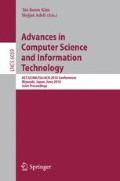Abstract
Because the nodes of a sensor network have limited node resources and are easily exposed to harsh external environment, they should be able to use energy efficiently, send data reliably, and cope with changes in external environment properly. Furthermore, the lifetime of networks adopting the multi hop routing is shortened by the energy hole, which is the rapid decrease of energy in the nodes surrounding the sink. This study proposes Dynamic Routing that solves the above-mentioned conditions at the same time by using a dynamic single path, monitoring its own transmission process, and moving the sink heuristically in response to change in surrounding environment. According to the results of our experiment, the proposed method increased network lifetime, and mitigated the energy hole and enhanced its adaptability to topological changes.
Access this chapter
Tax calculation will be finalised at checkout
Purchases are for personal use only
Preview
Unable to display preview. Download preview PDF.
References
Akkaya, K., Younis, M.: A survey on routing protocols for wireless sensor networks. Ad-hoc Networks 3(3), 325–349 (2005)
Karaki, N.A.I., Kamal, E.: Routing techniques in wireless sensor networks: A survey. IEEE Wireless Communications 11(6), 6–28 (2004)
Niculescu, D.: Communication paradigms for sensor networks. IEEE Communications Magazine 43(3), 116–122 (2005)
Bi, Y., Sun, L., Ma, J., Li, N., Khan, I.A., Chen, C.: HUMS: An autonomous moving strategy for mobile sinks in data-gathering sensor networks. EURASIP Journal on Wireless Communication and Networking, 1–15 (2007)
Zheng, Z., Wu, Z., Lin, H., Zheng, K.: WDM: An Energy-Efficient Multi-hop Routing Algorithm for Wireless Sensor Networks. In: Proc. International Conference on Computational Science, pp. 461–467 (2005)
Zhang, Y., Fromherz, M.: A robust and efficient flooding-based routing for wireless sensor networks. Journal of Interconnection Networks 7(4), 549–568 (2006)
Intanagonwiwat, C., Govindan, R., Estrin, D.: Directed diffusion: a scalable and robust communication paradigm for sensor networks. In: Proc. of ACM MobiCom, pp. 56–67 (2000)
Ye, F., Zhong, G., Lu, S., Zhang, L.: Gradient Broadcast: A Robust Data Delivery Protocol for Large Scale Sensor Networks. Springer Science Wireless Networks 11, 285–298 (2005)
Marta, M., Cardei, M.: Improved sensor network lifetime with multiple mobile sinks. Pervasive and Mobile Computing 5(5), 542–555 (2009)
Luo, J., Hubaux, J.P.: Joint mobility and routing for lifetime elongation in wireless sensor networks. In: Proc. of 24th Annual Conference of the IEEE Computer and Communications Societies, pp. 1735–1746 (2005)
Sensoria Corporation, WINS NG Power Usage Specification: WINS NG 1.0 (2000), http://www.sensoria.com/
Vergados, D.J., Pantazis, N.A., Vergados, D.D.: Energy-efficient route selection strategies for wireless sensor networks. Mob. Netw. Appl. 13(3-4), 285–296 (2008)
Chang, J.-H., Tassiulas, L.: Maximum Lifetime Routing in Wireless Sensor Networks. In: Proc. of the 4th Conference on Advanced Telecommunications/Information Distribution Research Program, pp. 609–619 (2000)
Choi, S.-Y., Kim, J.-S., Han, S.-J., Choi, J.-H., Rim, K.-W., Lee, J.-H.: Dynamic Routing Algorithm for Reliability and Energy Efficiency in Wireless Sensor Networks. In: Lee, Y.-h., et al. (eds.) FGIT 2009. LNCS, vol. 5899, pp. 277–284. Springer, Heidelberg (2009)
Author information
Authors and Affiliations
Editor information
Editors and Affiliations
Rights and permissions
Copyright information
© 2010 Springer-Verlag Berlin Heidelberg
About this paper
Cite this paper
Choi, SY., Kim, JS., Han, SJ., Choi, JH., Rim, KW., Lee, JH. (2010). Dynamic Routing for Mitigating the Energy Hole Based on Heuristic Mobile Sink in Wireless Sensor Networks. In: Kim, Th., Adeli, H. (eds) Advances in Computer Science and Information Technology. AST ACN 2010 2010. Lecture Notes in Computer Science, vol 6059. Springer, Berlin, Heidelberg. https://doi.org/10.1007/978-3-642-13577-4_14
Download citation
DOI: https://doi.org/10.1007/978-3-642-13577-4_14
Publisher Name: Springer, Berlin, Heidelberg
Print ISBN: 978-3-642-13576-7
Online ISBN: 978-3-642-13577-4
eBook Packages: Computer ScienceComputer Science (R0)

